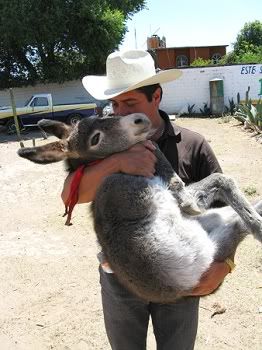Sanctuary rescues Mexico's vanishing icons
Small sanctuary rescuing fast-vanishing icons
by Sergio Solache - Apr. 22, 2009 12:00 AM
Republic Mexico City Bureau

Manager German Flores carries a young donkey at the Burroland donkey shelter. Many burros are being neglected as Mexicans switch to pickups and tractors.
OTUMBA, Mexico - You can hear the Burroland donkey shelter long before you see it, as the braying of jacks and jennies mixes with the mournful whistles of freight trains in this small town outside Mexico City.
Here, 20 donkeys wander behind a wire fence, munching carrots and leftover tortillas and waiting for pats on the head from the occasional tourist.
This shelter for unwanted donkeys would have once seemed a laughable idea in Mexico, where the hard-working burro is practically a national symbol. These beasts of burden carried settlers over the Sierra Madre, hauled gold from mines and pulled plows through Mexican fields for centuries.
But Mexico's donkeys are quickly being replaced by pickup trucks and tractors even in the poorest areas, prompting efforts to save unwanted animals and remind Mexicans how much their country owes to burros.
"People love them, but there's not as much work for them anymore," said Luis Huerta, a member of the Donkey Sanctuary of Mexico, a group of veterinarians who help the Burroland shelter.
Mexico's population of donkeys plummeted from 1 million in 1991to 581,000 in 2007, according to Mexico's National Institute of Statistics, Geography and Data Processing. Many are killed by their owners or end up in slaughterhouses, Mexico's Society for the Protection of Animals says.
It's a sad end for an animal that once thrived in Mexico. Burros, loosely defined as a donkey 40 to 48 inches tall, were brought to the New World by Spanish colonists, said Leah Patton, registrar for the American Donkey and Mule Society.
Otumba, 45 miles northeast of Mexico City, became a major animal market.
The donkeys that were once sold here pulled carts of silver and gold from Mexico's mines, bringing fabulous wealth to the Spanish empire.
They carried silks and spices from the Pacific Ocean to the Atlantic Ocean as part of the trade route to Asia. And donkeys accompanied pioneers pushing west and north through the Americas.
"These are animals that basically built the continent," Patton said.
But, in most parts of Mexico, donkeys are associated with backwardness and rural poverty, Huerta said. As Mexicans become wealthier, many farmers are getting rid of their animals.
"They're not even worth 500 pesos ($38) these days," said German Flores, manager of Burroland. "The people who have burros are peasants over age 60 who still value the animal's work. The newer generations prefer a pickup or a tractor to a burro."
The animal's fate has inspired some efforts to save them. Donkey Sanctuary has begun sending a mobile veterinary clinic around Mexico to treat donkeys for free because farmers no longer want to spend money caring for them.
The Mexican Society for the Protection of Animals is campaigning to bar the killing of unwanted donkeys and horses at slaughterhouses. And the government of Jalisco state imported a few males from a taller, stronger breed in Kentucky in an effort to revive interest among farmers.
Flores, an accountant, bought some land next to his family's home and opened the Burroland shelter in 2006.
The place is not exactly scenic: The donkeys wander among rusting 1940s-era cars scattered around the dirt lot.
Visitors are given donkey ears and tails to wear as they visit a small museum, complete with papier-mache burros.
There are puppet shows and burro rides. Children can pose for pictures with staff members dressed like the donkey from "Shrek" or Eeyore from "Winnie the Pooh." Admission is free.
Burroland lives mainly off donations from visitors, local companies and international groups like Donkey Sanctuary in Britain. It costs about 200 pesos a day, or $15, to feed each burro, Flores said.
"I'd like to have more burros here, but it would be irresponsible because we don't have the money to keep and feed them," Flores said.
The shelter's residents have colorful histories. Roberto used to pull a cart for a junk collector in Mexico City until a bus hit him head-on, breaking both front legs. Apache, a white burro with brown spots, was rescued from a forest fire.
The shelter gets about 30 visitors on a good weekend, Flores said. He eventually wants to add a snack shop, expand the museum and build stables for all the donkeys.
"We want it to be a sustainable project and leave it as a legacy for Otumba and all of Mexico," he said.
Republic reporter Chris Hawley contributed to this article.









No comments:
Post a Comment